Dear readers,
Today, I’m sending out a slightly reworked early essay on the beautiful city of Venice - one that happens to be among my personal favorites. It will be new to most of you, but not to everyone and so, as always, I have to say thank you to those who have been reading my letters since the beginning. A big welcome, too, to new subscribers.
And while I’m at it, I might as well thank everyone in between, too…I’m so glad you’re here.
And now, off to Venice…
{Venice, Italy}
Is there a moment in travel more magical than stepping out of the Santa Lucia train station in Venice, and gazing at the Grand Canal for the first time?
Amid the chaos of street vendors, teenagers flying by on scooters, and travelers rushing to buy tickets for a vaporetto that will take them deeper into the city, I stop for a second to take in the scene. Instead of concrete, there is water. Instead of buses and cars, the canal is crowded with gondolas and motorboats, both small and large. When I expect to hear the squeal of tires, only the sound of lapping water meets my ears. I silently will the chaos around me to disappear, look into the distinctive sea-foam green water of the canal, watch it gently break against the stone steps of the domed church across the way, and give thanks quietly for this miracle of a city.
I am lucky, it is a crisp fall day. The air is cool and clear, and the skies are pale blue with delicate white clouds. The forecast says rain for the next three days, but as it turns out the forecast lies: each morning the canals fill with fog - a disconcerting fog, so thick that it settles on my eyelashes and blurs my vision - but the fog breaks early and soon enough the sun starts to shine as brightly as it does on my first day here.
It is not far from the train station to my hotel and so I decide to walk. The route I follow takes me down what must be the most touristy street in Venice, lined with fast-food restaurants, chain stores and shops selling cheap trinkets. After quickly checking into my hotel, I walk to Piazza San Marco. It is late in the afternoon, and the square is packed with people. This is the one thing that you can’t help noticing about Venice right from the start: the heart of the city is absolutely swarming with tourists. I can’t rightfully complain, because I know full well that I am a tourist myself. But, it would be easy to get so incredibly frustrated by the crowds that you would miss the otherworldly beauty and history all around you here. And that would be such a shame.
So I decide that in a city like Venice sometimes you have to pick and choose what you allow yourself to see. And when I find myself getting frustrated, I stop, squint a little bit, and let my mind wander back to the past…
{ January, 828. Two Venetian merchants arrive back in Venice after a trip to Alexandria. They are carrying a bundle with them, and it smells vaguely of pigs…}
The first thing that you notice about Piazza San Marco is that it is absolutely enormous. To be honest, it takes me a few minutes to even register the Byzantine basilica at one end, my eyes are so taken by the brilliant white arcaded buildings lining the other three sides of the square. The arcades are filled with shops and cafés - several of the cafés have music platforms, and as the evening progresses they play live orchestral music, taking turns so as not to drown each other out. Near the southeast corner of the large square is a much smaller square that leads to the part of the lagoon known as the San Marco basin. This is the Piazzetta and it is bordered, on one side, by the Doge’s palace, home for centuries to the rulers of Venice. Close to the water are two columns, the columns of San Marco and San Teodoro. San Teodoro (St. Theodore) is the patron saint of Venice in 828, when our two merchants arrive from Alexandria.
Things are looking pretty bright in Venice in 828. The republic is becoming more powerful, and locals start to wonder if St. Theodore is important enough to be their city’s patron saint. Rome has St. Peter, after all, and he’s about as important as it gets. Venetians are jealous. Two merchants take matters into their own hand - they plan an excursion to Alexandria, to “recover” the remains of St. Mark the Evangelist. They smuggle him back to Venice underneath a pile of pork and vegetables, so as not to be disturbed by Muslim inspectors on their way out of Egypt. After a journey filled with trials, they arrive back in Venice at the end of January. Venice has a patron saint they can be proud of, and they get to work building a basilica to honor him.
The basilica that stands at one end of Piazza San Marco today was completed in 1094. It is covered, inside and out, in mosaic tiles and colorful marble. People wait in line to visit the basilica all day, every day. Venice is very proud of the basilica, and the square that shares its name - but I can’t help noticing that they don’t really talk a lot about how St. Mark came to Venice in the first place.
I get up early the next morning to get coffee and to walk around a little before the crowds descend. I make my way to the Rialto Bridge, and over to the market on the other side. The first wooden bridge in Venice - lined with shops on both sides - was constructed here in 1255. The Republic of Venice was at the height of its power in the 13th century, and this little corner was a center of international trade. Rugs, silks, tapestries, and spices arrived from the Far East via the Silk Road and filled the shops on the bridge and along the market nearby. The wooden bridge was susceptible to collapse, and a competition was held in the 16th century for a design to replace it with a sturdier structure in stone. The Venetian architect Antonio da Ponte won the competition, and the Rialto bridge was completed under his direction in 1591. It was considered an architectural marvel at the time - wide enough to accommodate two rows of shops and three stepped walkways, it was also high enough in the center to allow ships to pass through. All of this while being truly lovely to look at. For three hundred years, the Rialto Bridge was the only spot in Venice where you could cross the Grand Canal on foot.
Still seeking quiet, I walk towards the Fondamente Nove, the embankment on the north side of Venice. On the way, I stop into a church with the longest name ever: Chiesa di Santa Maria Assunta detta I Gesuiti. There are hundreds of churches in Venice, and I poke my nose into as many as I can while I’m here. They are almost all lovely, but this is my favorite. The interior is completely decorated in green and white marble - with a decorative pattern resembling jacquard covering most of the walls. The green marble reminds me of the lagoon, and the pattern is reminiscent of the silk and brocades that passed through the Rialto Market. It is unusual, and I like it. John Ruskin - who wrote the 19th-century Venetian travel book, The Stones of Venice, disapproved, but what did he know?
{1450. The port of Venice. A hooded monk stops a merchant returning from abroad. He has some questions for him…}
From the Fondamente Nove, I have a good view of Isola di San Michele, Venice’s cemetery island. For centuries, Venetians would bury their dead underneath the stones of the city, but - because of health concerns - that practice was halted in the early 19th century. Now, this cypress-crowded island is where Venetians come when they die. And this, in 1450, is where we meet our hooded monk. His name is Fra Mauro, and - in addition to being a monk at the island’s monastery -and their accountant - he is a cartographer. Venice was the perfect home for a cartographer in the 15th century…still a center of trade, foreign merchants and visitors traveled through on a daily basis. Fra Mauro would corner them as they arrived in Venice, ask questions about their homeland, and gather information about their voyages and what they had encountered along the way. He made very careful notes. When he compiled his map, it included over 3000 hand-written notations.
The finished map is considered one of the masterpieces of world cartography: the greatest European map of its time. It is on display at the Correr Museum, at one end of the Piazza San Marco. It is a marvel, brilliantly hand colored on vellum - though it does take a minute to orient yourself as north is down and south is up. Fra Mauro didn’t get everything correct - he asserts, for example, that England used to be inhabited by giants - but for its time the map is incredibly accurate. Somewhat ironically (as it was drawn by a monk) the map is considered groundbreaking in that it was one of the first that didn’t consider Jerusalem the center of the world.
{1495. A new printing press opens in a small storefront. A young printer sorts through type…}
On the other side of the Grand Canal, everything is calmer. I like it over here. It feels less touristy. Venetians seem to be going about their daily business here - shopping for produce on a floating fruit barge and ducking into bakeries. I visit the Frari Basilica, where the Venetian artist Titian is buried, and secretly think to myself that it is much more interesting and beautiful than St. Mark’s Basilica and there is no line here at all. Afterward, sitting on a bench in a nearby square I watch as a group of young people walk by serenading a recent graduate: “Dottore, dottore”, they sing…
It was in this neighborhood in 1495 that Aldus Manutius set up the Aldine Press. Printing was in its infancy in 1495, and most printed books were still large, unwieldy, and prohibitively expensive. Aldus, a scholar and teacher, opened his press with the goal of making classical texts available to a wider audience. He collaborated with a group of scholars, who would gather in his little print shop, working on translations of Greek and Latin classics. Instead of using heavy Gothic black-letter type to print his books, he produced typefaces in a new, easy-to-read font that mimicked handwriting, which he called italic, and then created the first set of type that allowed books to be printed with Greek letters.
But most importantly, he printed his books in small, lightweight editions - the first printer to produce books in the size we know them today. The books were portable and more importantly, affordable, and as such Aldus’s lasting legacy is not only beautiful books but the democratization of knowledge.
The next day I walk over to Piazza San Marco for the final time. I look around. There are so many more stories to tell, just in these few blocks:
{1609. A young professor from nearby Padua named Galileo Galilei brings his new discovery, the telescope, to the bell tower of St. Mark’s and shows the Doge of Venice how he can view the heavens…}
{1723. A redheaded priest named Antonio Vivaldi writes a new set of concerti - The Four Seasons - while working as a violin teacher at a girl’s school a stone’s throw from the Bridge of Sighs. It is performed at the church nearby…}
{1756. A prisoner named Giacomo Casanova breaks out of his cell beneath the Doge’s Palace, where he has been imprisoned for crimes against the Holy Church. He flees to Paris, and begins to write the story of his life…}
So many stories. Every city has stories, but somehow they seem more important here. I want to hold onto them more closely. I find myself wanting to write them down so that I don’t forget.
I walk from Piazza San Marco to the Academia Bridge and watch as two painters set up their easels to paint the view. I take a few final photos of the Grand Canal.
The Grand Canal is lined with about 170 palaces and public buildings. They haven’t changed much over the years, most of them date from the 13th to the 17th centuries. Their histories are richly documented. It’s tempting to say that there are no secrets here, but who am I kidding? There are probably a million secrets along the banks of the Grand Canal. Still, the stories here come fast and furious. We know who lived in these buildings, and when…and what they did there.
Standing on the Academia Bridge, looking towards the San Marco basin, you can see a palazzo to your left, just past the one painted a deep ochre color. That’s the Palazzo Barbaro. At the end of the nineteenth century it was owned by a wealthy American, Daniel Sargent Curtis. His cousin, John Singer Sargent was a frequent guest, and the palazzo became the center of ex-pat artistic life in Venice. Frequent guests included Edith Wharton, James Abbott MacNeil Whistler and Robert Browning. Isabella Stewart Gardner stayed for long stretches - Anders Zorn painted her portrait here. One year, she invited the novelist Henry James to visit - he wrote The Wings of the Dove during his stay. It is partially set in Venice.
Further down the Grand Canal on the right you can just make out the Casa Semitecolo, where Henry James’ close friend - the American writer Constance Fenimore Woolson - jumped to her death in 1894. Across the way is the Palazzo Ca’Giustinian, where George Eliot’s much younger new husband flung himself into the Grand Canal in a suicide attempt on their honeymoon. He later wrote that he was overcome by the Venice heat. The building plays host to the Venice Biennale these days.
The low-slung white palazzo on the right is one of the most famous of all. It is Palazzo Venier dei Leoni, the former home of Peggy Guggenheim and now a museum that holds her world-class art collection. Before Guggenheim, it was owned by wealthy British socialite Lady Doris Castlerosse, and before her the Marchesa Luisa Casati, who considered her life a work of art and who never left home in less than full flamboyant costume, her pet cheetah at her side.
There are palazzos that are haunted, of course, and palazzos that are thought to be cursed. I try to take note of them all.
Looking at the Grand Canal I remember that a long, long time ago - long before the bridges and palazzos, long before there were people to admire its beauty - it was a river. A river cutting through a landscape that over time filled with water, so that only a series of small islands remained. And soon, experts say, those islands may be gone, too. Venice is in peril, and the threat is real. Pretty soon, all of this may be gone.
Vivaldi gone. Titian gone. Canova and Palladio, Casanova and San Marco. Gone. The Venice of Shelley and Byron, Henry James and John Ruskin, gone.
Standing on the Academia Bridge, my throat tightens. It’s all so lovely. Is Venice really the most beautiful city in the world? Or does it just seem that way because - like life - its beauty is amplified by its fragility?
I don’t know, but I do know that it’s all too much to lose. And so I keep making notes and taking photos, until the sun goes down and the moon comes out and the light starts to reflect off of the darkened water….
XO
If you enjoyed this letter, please consider becoming a subscriber to have Beautiful Things delivered to your inbox. Subscriptions are free unless you choose otherwise. If you are interested in reading my previous letters from abroad, visit my homepage: Beautiful Things. And finally, a note that paid subscriptions are on sale half-off until the end of October: only $15 will grant you access to the archive for an entire year.





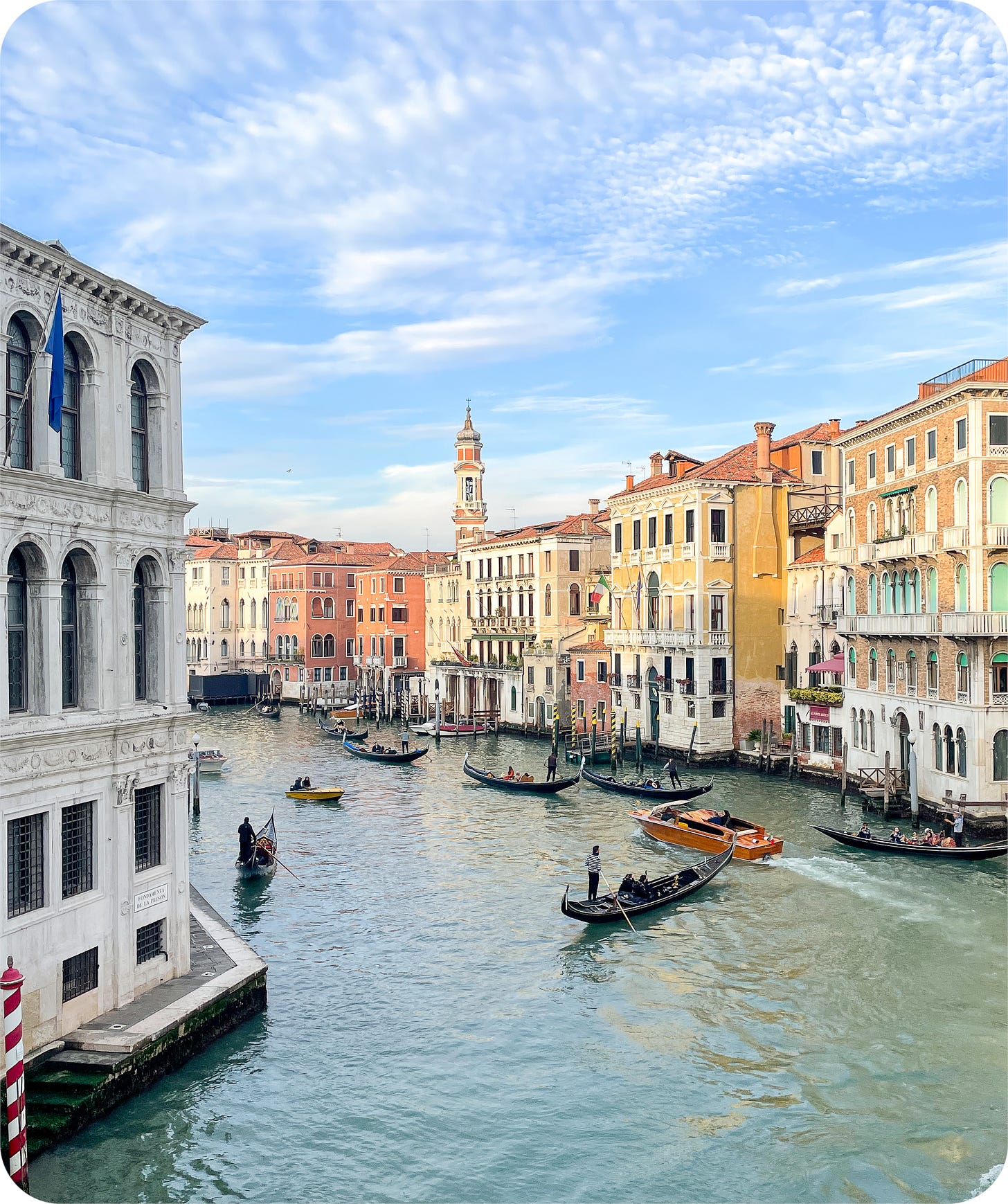



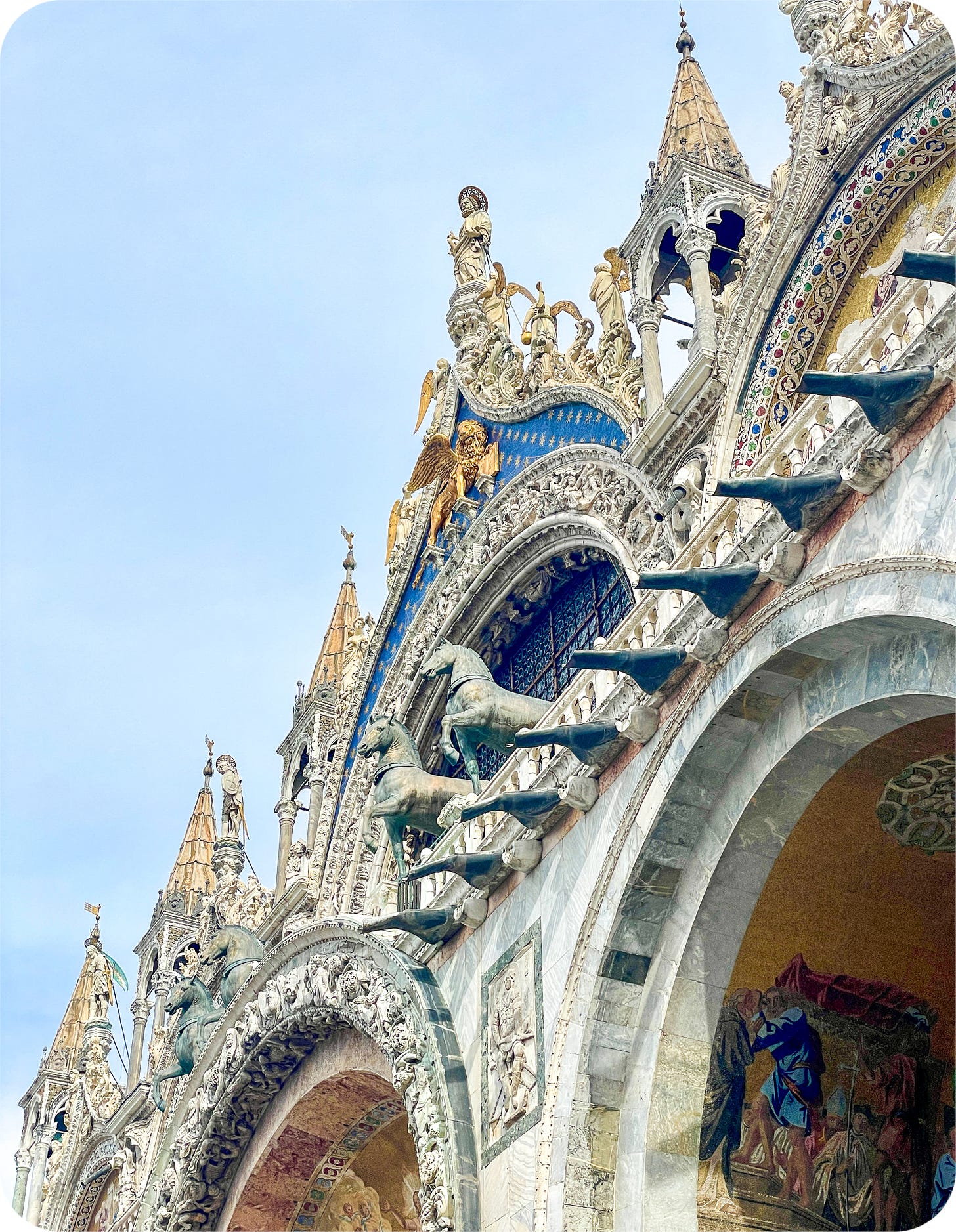
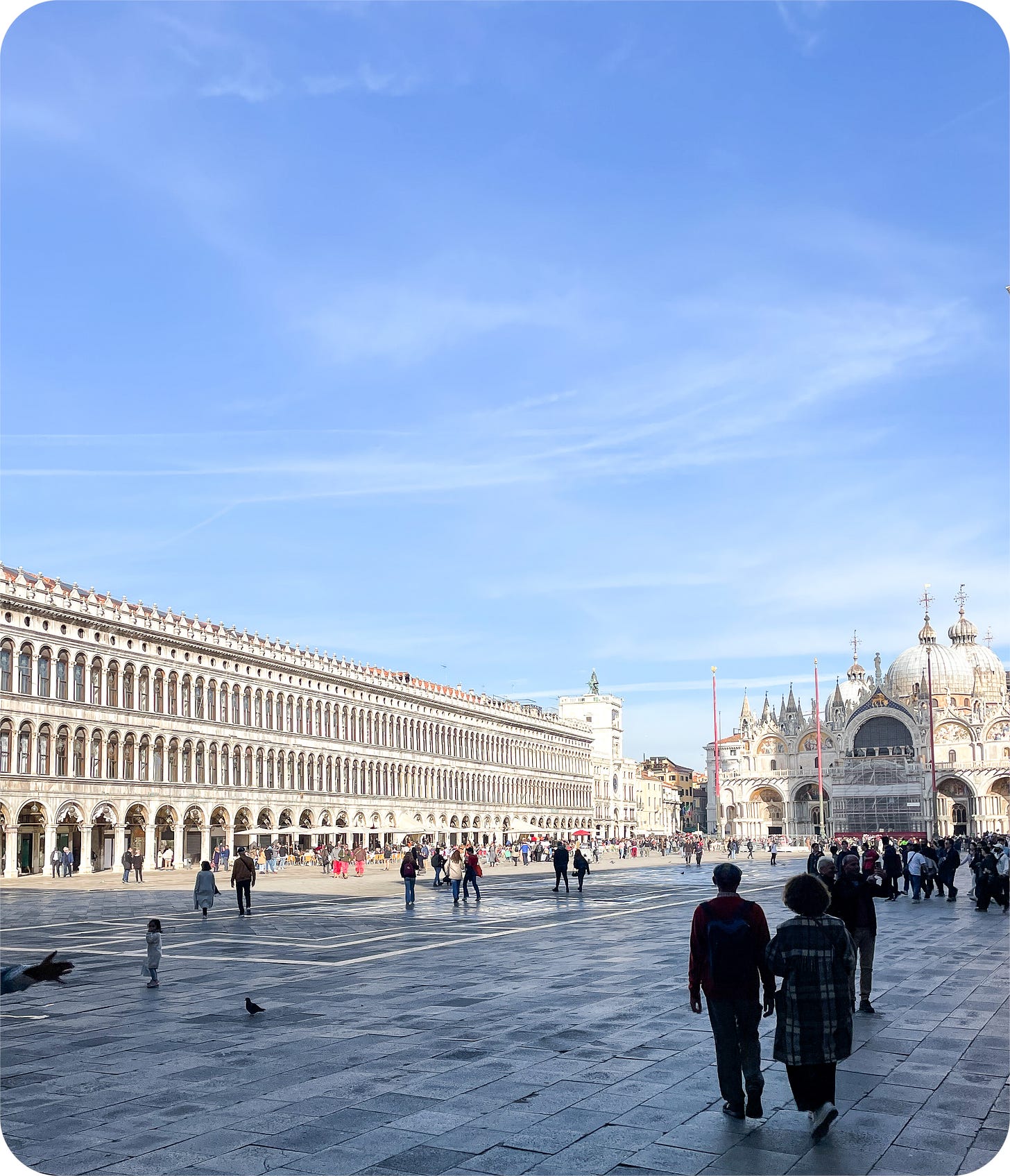
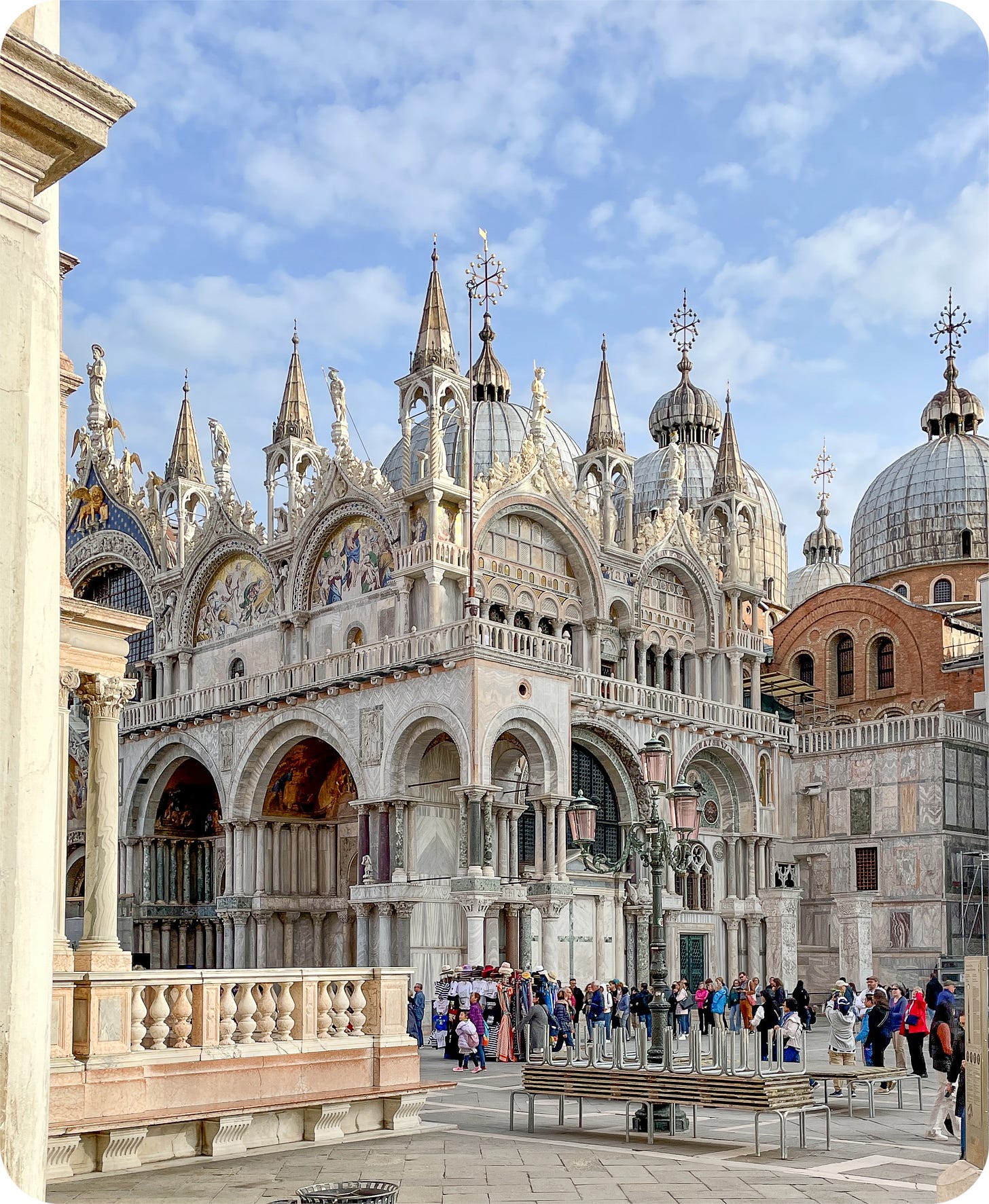

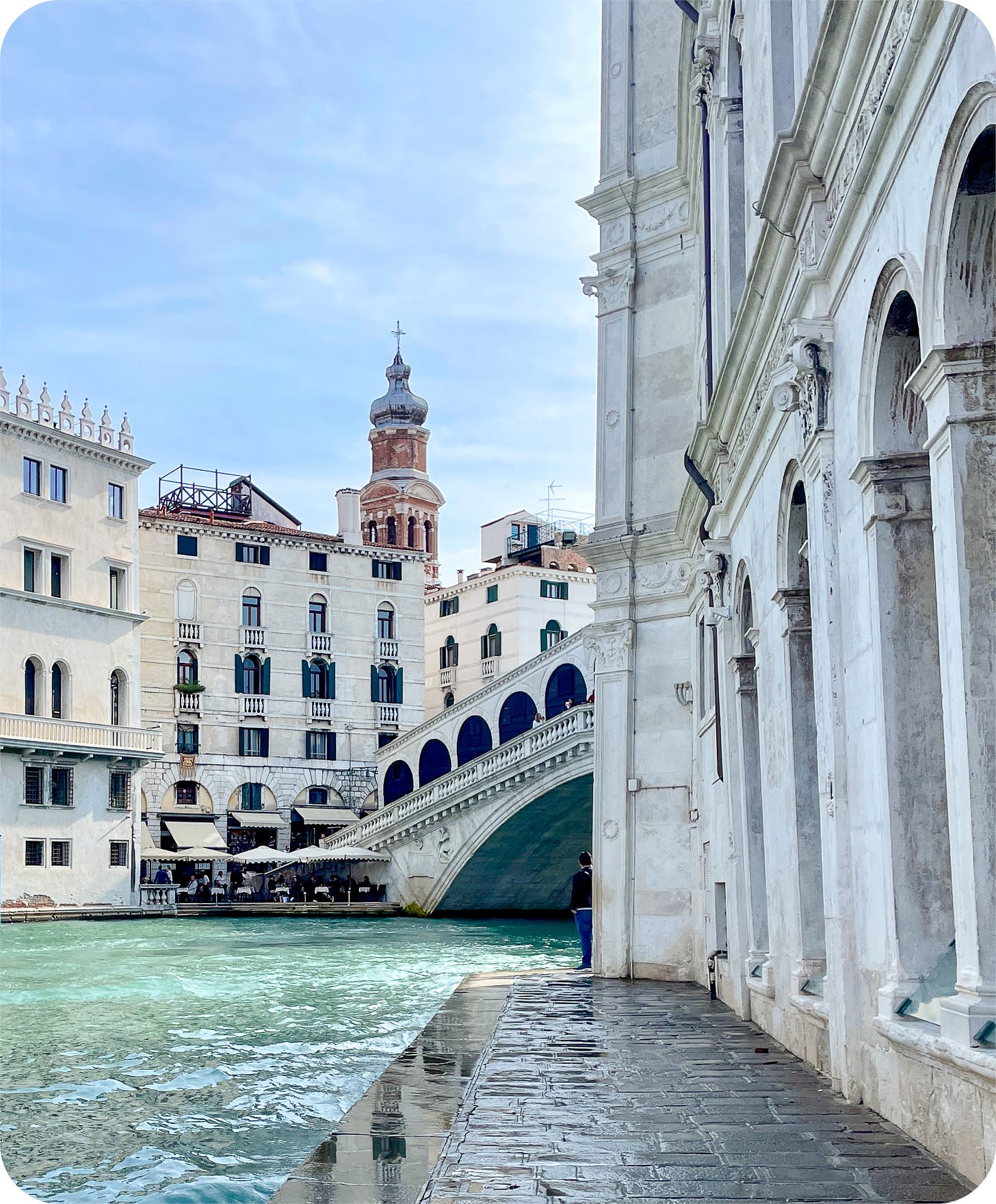
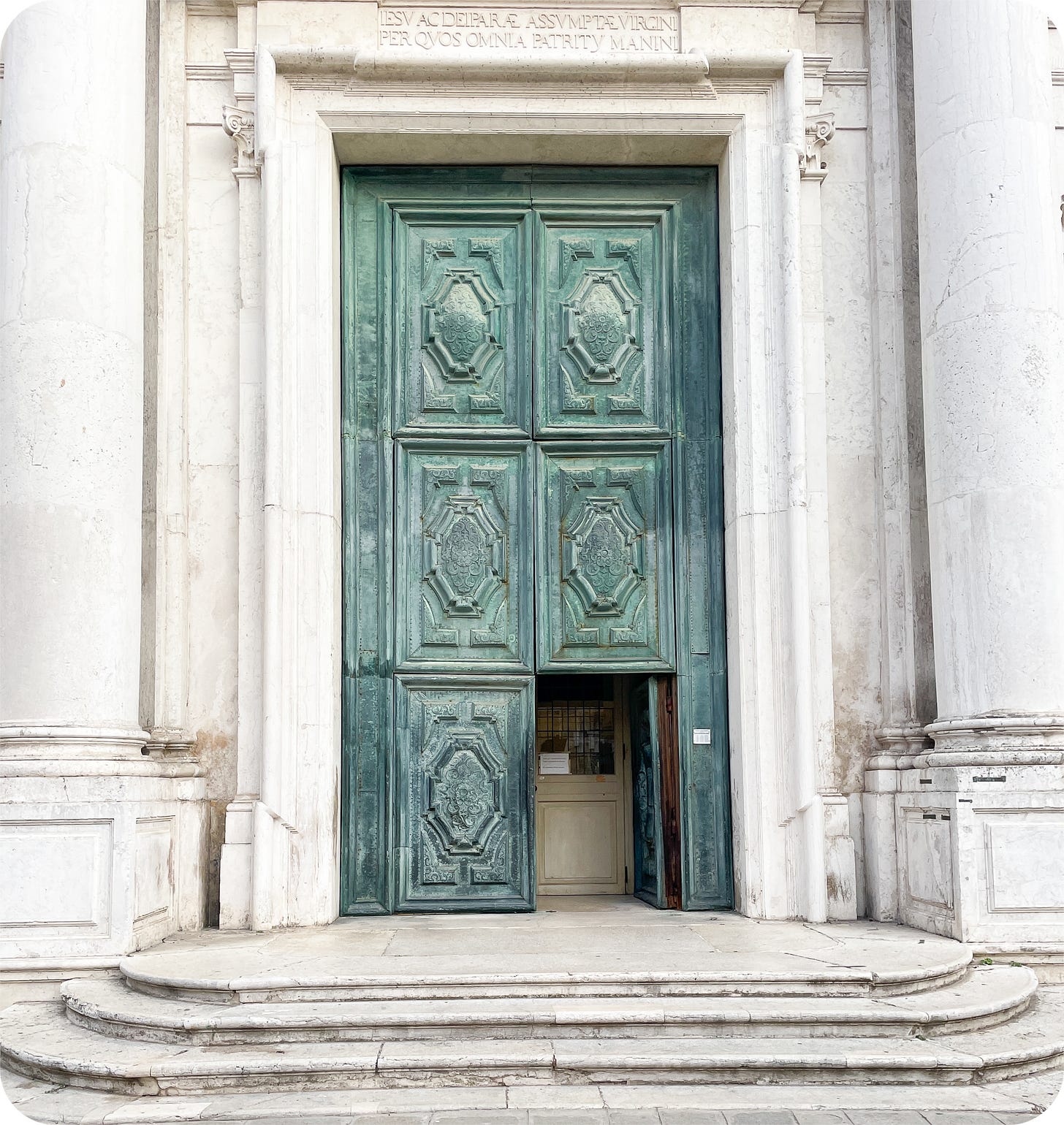
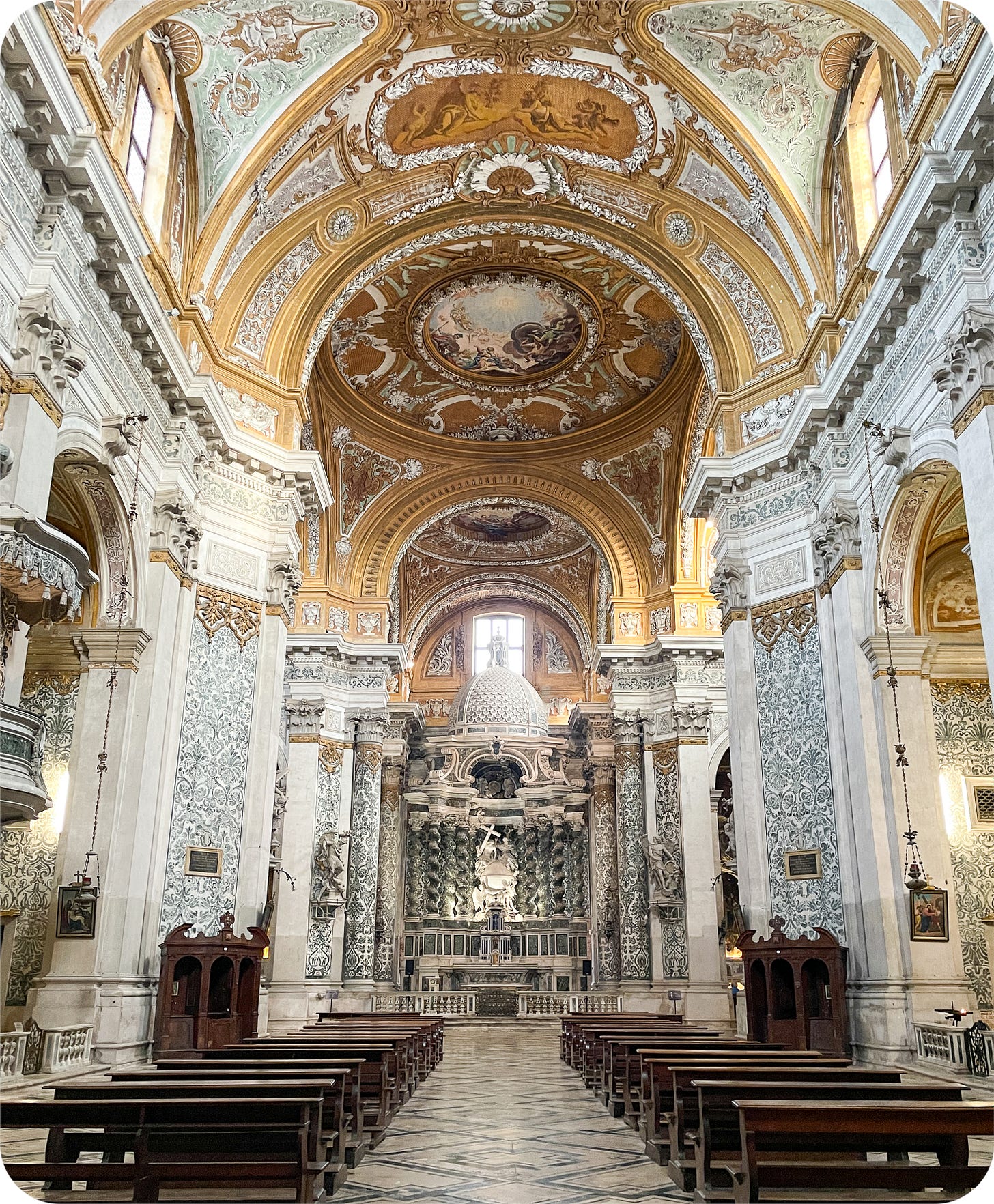
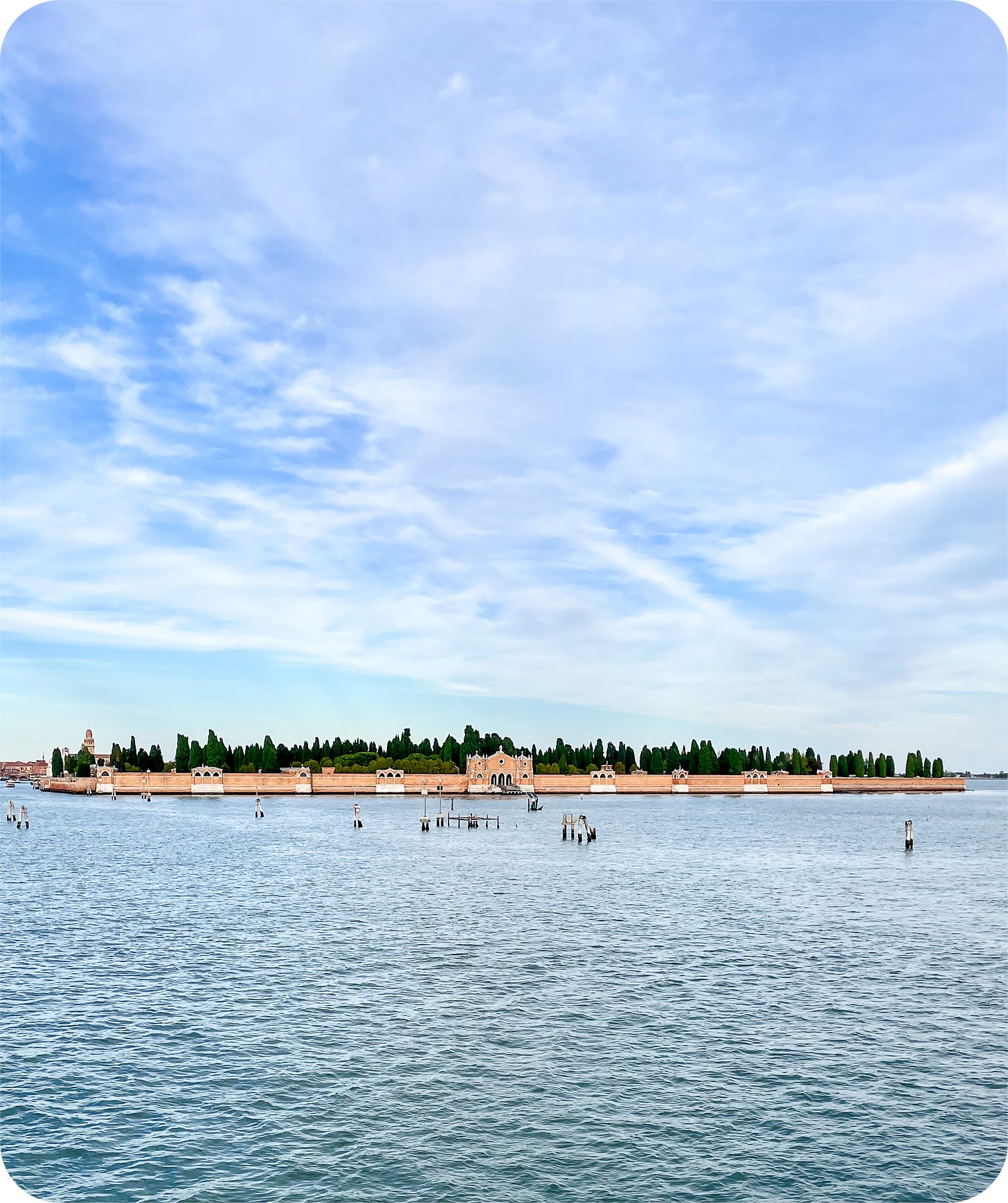
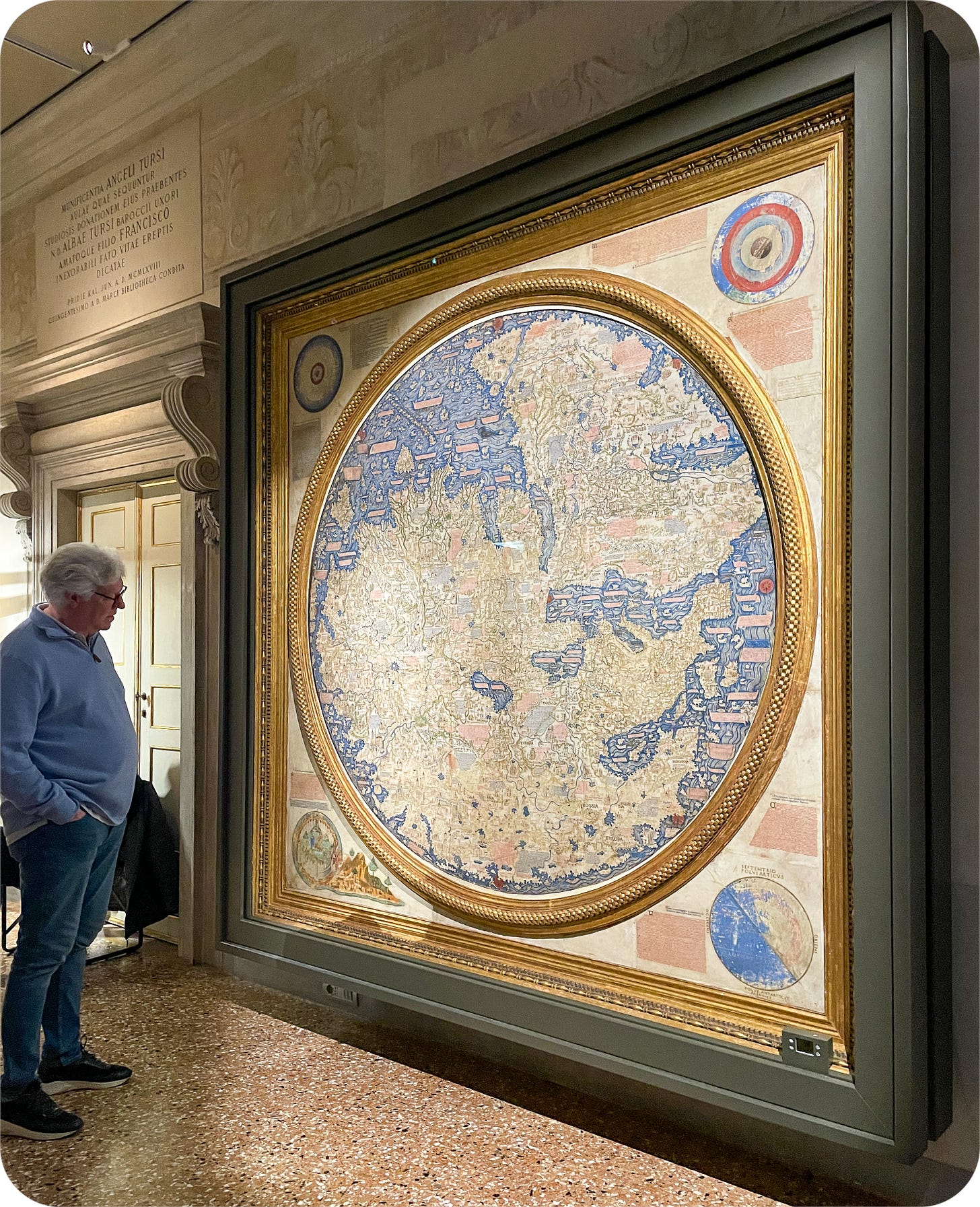
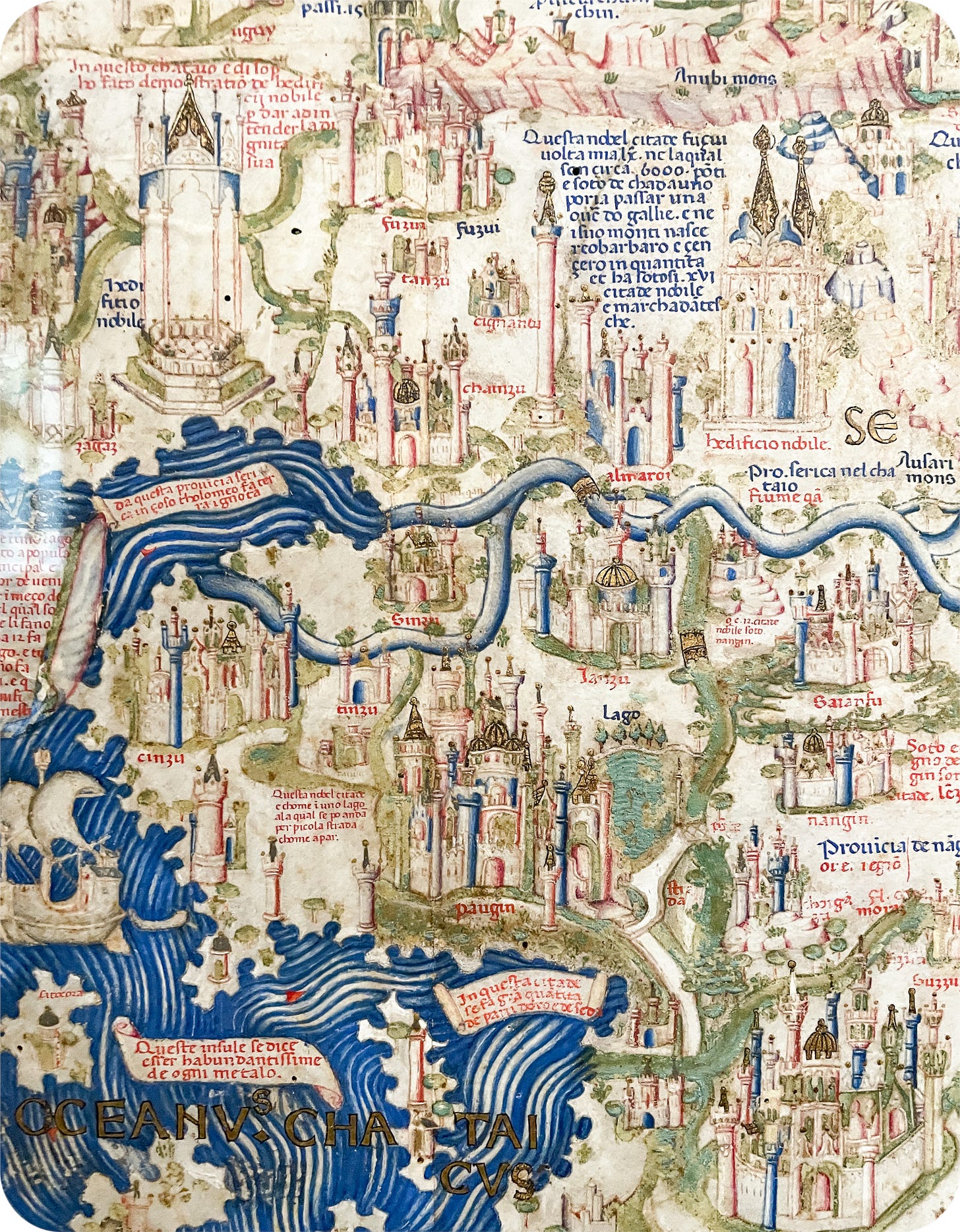
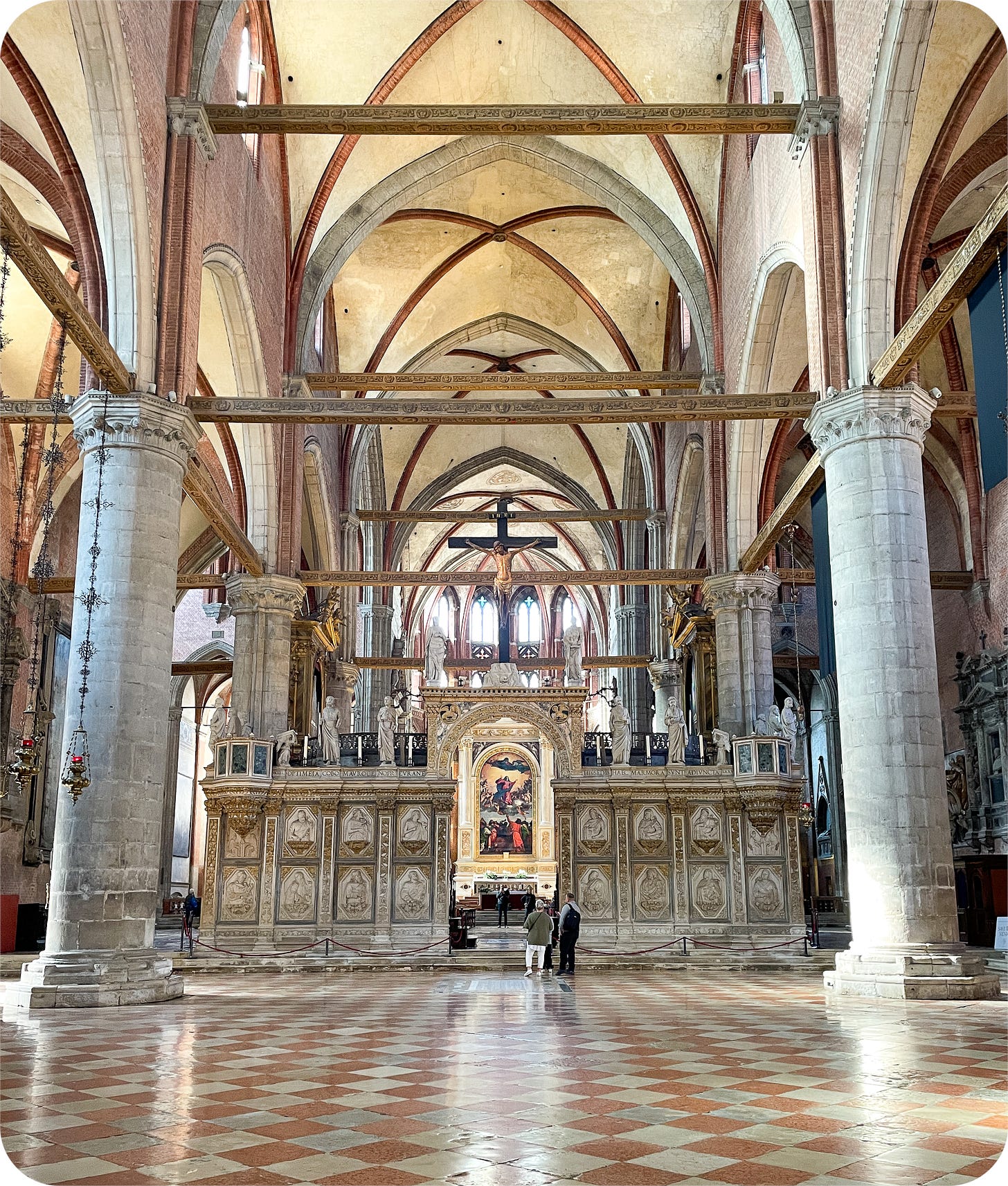
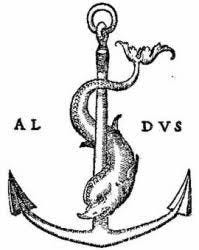

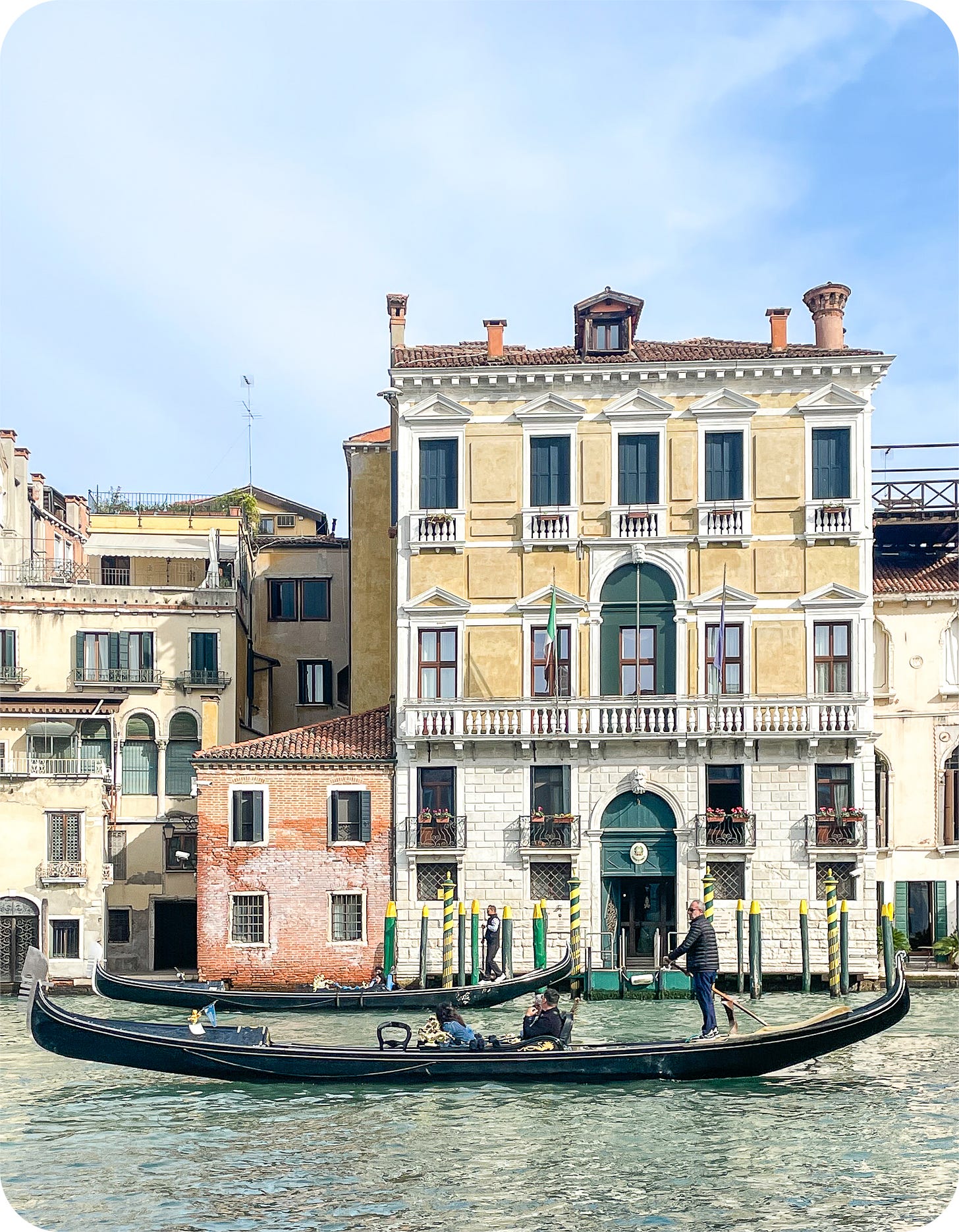

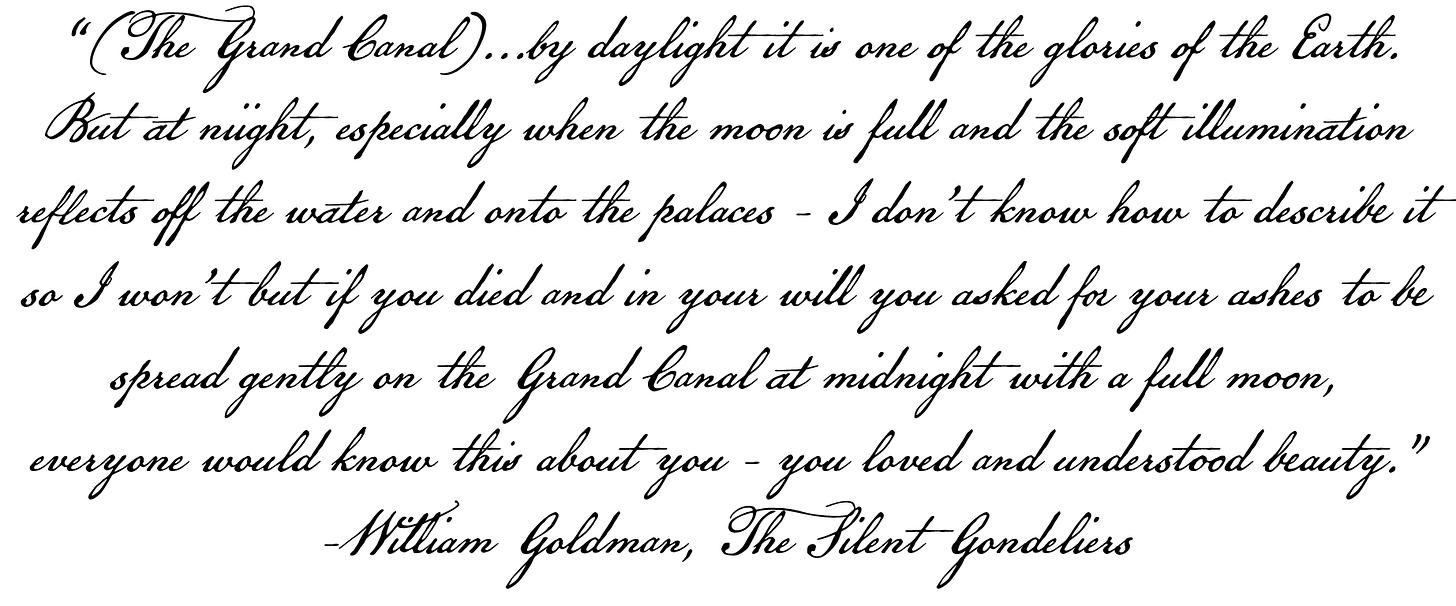
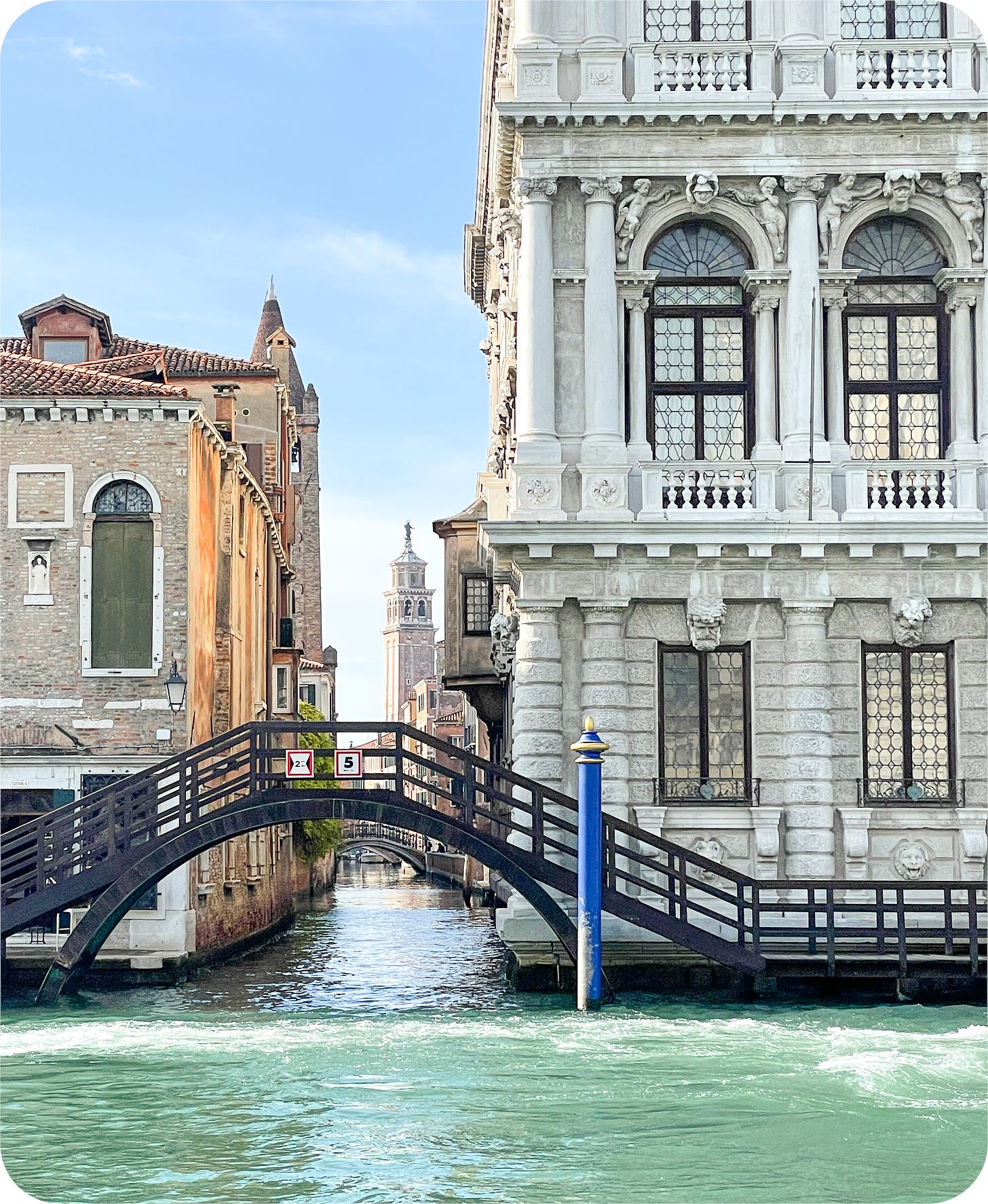

Ruskin was probably looking at the I Gesuiti wall colours and thinking “hmm William Morris got here first?”
Venice in a softer light is a lovely sight. Thank you for your insightful photos.